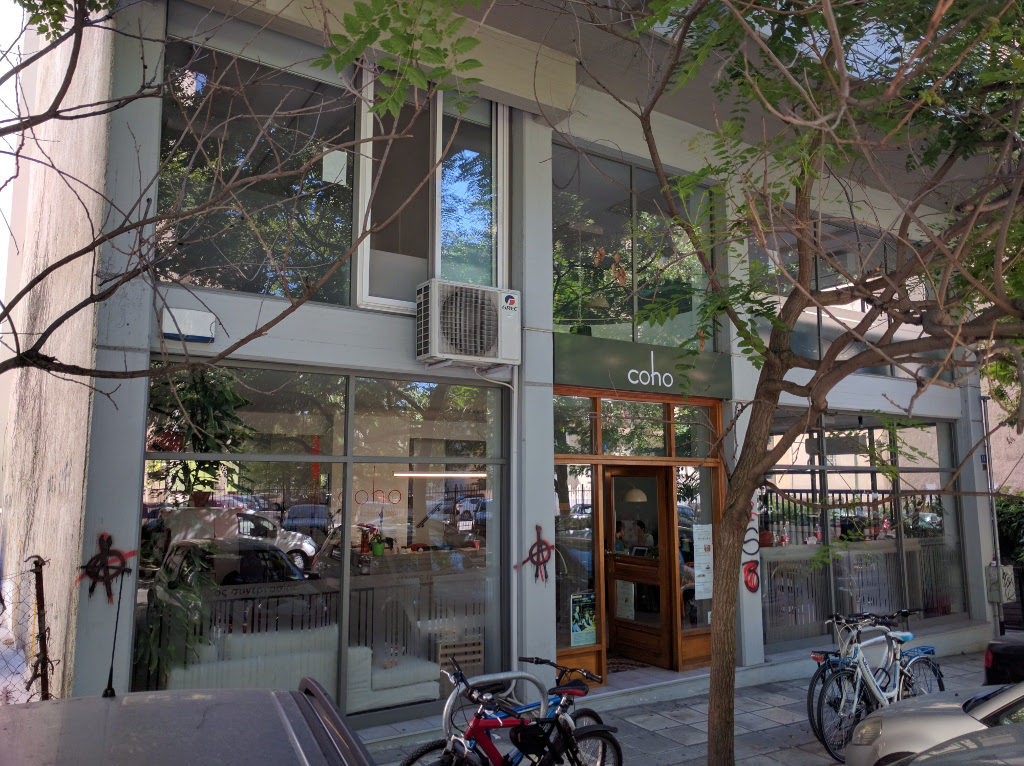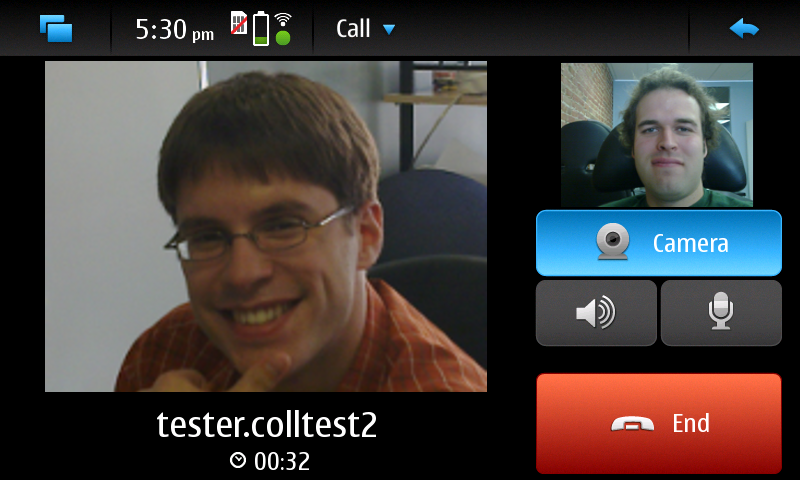Le blog de Olivier Crête
After missing the last few GStreamer hackfests I finally managed to attend this time. It was held in Thessaloniki, Greece’s second largest city. The city is located by the sea side and the entire hackfest and related activities were either directly by the sea or just a couple blocks away.
Collabora was very well represented, with Nicolas, Mathieu, Lubosz also attending.
Nicolas concentrated his efforts on making kmssink and v4l2dec work together to provide zero-copy decoding and display on a Exynos 4 board without a compositor or other form of display manager. Expect a blog post soon explaining how to make this all fit together.
Lubosz showed off his VR kit. He implemented a viewer for planar point clouds acquired from a Kinect. He’s working on a set of GStreamer plugins to play back spherical videos. He’s also promised to blog about all this soon!
Mathieu started the hackfest by investigating the intricacies of Albanian customs, then arrived on the second day in Thessaloniki and hacked on hotdoc, his new fancy documentation generation tool. He’ll also be posting a blog about it, however in the meantime you can read more about it here.
As for myself, I took the opportunity to fix a couple GStreamer bugs that really annoyed me. First, I looked into bug #766422: why glvideomixer and compositor didn’t work with RTSP sources. Then I tried to add a ->set_caps() virtual function to GstAggregator, but it turns out I first needed to delay all serialized events to the output thread to get predictable outcomes and that was trickier than expected. Finally, I got distracted by a bee and decided to start porting the contents of docs.gstreamer.com to Markdown and updating it to the GStreamer 1.0 API so we can finally retire the old GStreamer.com website.
I’d also like to thank Sebastian and Vivia for organising the hackfest and for making us all feel welcomed!

Mark his words and laugh in two years.
Due to unintentional behavior breakage in the newest versions of GUPnP and GSSDP, the UPnP NAT traversal in all VoIP applications that use Farsight2 is currently broken. This includes Empathy, Pidgin, aMSN, etc. I advise distributors to just stay with the older GUPnP 0.16 (and GSSDP 0.10) releases until this is sorted out. For those who care, the details are on bugzilla.
Update: I’ve released GUPnP-IGD 0.2.1 that works around these problems.
Just like everyone else on Planet GNOME,

You are all cordially invited to my talk: Improving the quality of video calls on the Free Desktop. I will try to explain why Skype’s video calls look so much better than ours and what I’ve been doing to fix it, and how there is much more to do.
Now that WebRTC and RTCWeb are coming, it is more critical than ever that we can have good quality video calls in the GNOME platform so we can stay relevant.
I’d also like to thank my employer, Collabora, for once again sponsoring my trip. And don’t forget the Collabora party on Tuesday night!
The PR1.2 update of the N900 firmware is now officially released. The big new feature is video calls. It is also the world’s first phone to offer Skype video calls as well as Google Talk compatible video calls! And all of this uses Farsight2, the GStreamer based voice and video calling library. The whole Farsight2 team is very proud to have been able to participate in this world first. And just like all other calls on Maemo, video calls use the Telepathy framework. We obviously also support Jingle (aka Jabber aka XMPP) and SIP just like the N800 and N810. But we also add H.264 support.

As a side note, my colleague Sjoerd (who now has a blog!) has made VP8 work with RTP. The Googlers are working hard to make some kind of standard. So hopefully, with Google’s clout, we’ll be able to have calls between a fully free platform and a hardware phone!
I’m in Bangalore for foss.in. First, the country is awesome, the Indian food is amazing, etc, etc. The weather is also pretty nice this time of year, not too warm, not too cold, just right. Although it has been a bit rainy in the last three days.
But its not only the country that is nice, it is also an awesome conference, the organizers are really doing a great job. The venue is nice, the speakers are really well treated, etc. But more importantly, the level of the conference is also quite impressive. It is a great place to meet lots of good developers that we rarely meet in the “western” conferences. Free Software is really alive in India and it is great to meet the people here. After my Farsight 2 talk (slides), there were some really good questions, from people who had actually tried to use it. It’s the fourth (and last) time that I give this talk in front of different audiences, and I really got the best questions and the best interaction. The organizers wanted to make it into a truly developer oriented conference and they’ve really succeeded.
Students! There are only a few days left (until Monday) for you to submit your Google summer of code applications. This year, I’m hoping to mentor students working on Farsight 2 or on integrating Farsight in various applications. The most interesting project I’m proposing this year is adding plugins for the various non-free protocols to Farsight (see details), MSN is particularly easy since most of the reverse-engineering has already been done, its just a matter of coding it. GStreamer has a page on how to write a good application (hint hint, Farsight’s project are part of GStreamer this year!). I’m also a mentor on Gnome & Gentoo in case anything interesting is proposed there, so if you have good idea, go submit them now, time is running out!
Update: Google has extended the application period for one more week, so there’s still time… And we already have a good applicant for MSN, but please do apply for Yahoo, AIM, ICQ, etc!
First, this is my first post on Planet Gnome, so I’ll introduce myself. I’m one of the developers of GnomeICU and Farsight. I work for Collabora, mostly on Farsight and related things. For those who don’t know, Farsight is the GStreamer based audio/video conferencing framework used in Telepathy. Its most prominent platform is currently Nokia’s Tablet, but its coming to a desktop near you soon.
For the last two months, I’ve been working on a complete redesign of Farsight, in an effort we call Farsight 2. The new generation RTP plugin is based on the excellent RTP implementation by Collabora’s own Wim Taymans. With it, we gain some exciting new features, most prominently A/V synchronization and multi-party conferencing. Also, the first generation wasn’t designed with video in mind and it wasn’t nice, but this time we’re trying to make it right. It’s now a GStreamer element that implements an interface, so it can easily be used in GStreamer based applications to give some of the integrated features Telepathy is designed for. I’m also trying to have nice unit tests, so we can try not to have the same kind of regressions we keep on fighting with Farsight 1. We also want to keep the API as simple as possible and well documented.
This week, I’ve finally reached an important milestone.. it works! So I had to make a screencast (sorry for cutting it a bit short at the end and no, its not slow, its the screencast thats 10fps):
For those who want to try, you need the CVS HEAD of gst-plugins bad, and for the demo gui, a patch to gst-python. Then you can try my git tree. It’s all very new, so if it breaks, you keep the pieces. I’d also like to thank Philippe Khalaf and Youness Alaoui who worked a lot on the design and all the people who wrote the code that was carried over from previous versions of Farsight.
Update: Oops, the git repository was not fetchable by http, its now fixed… Updated again: now we have a gitview and git server, so I’ll let the link point there instead
Last week was GUADEC in Birmingham, it was really fun, I got to see some old friends and also meet many people that I only knew from IRC, including many Collaborans, they really are a nice bunch. And even some Gentoo developers! There were lots of interesting talks, great Ale (and Pimm’s!).
Nokia also released a Developer Preview of the new RTCOM software which includes the latest version of Farsight. So you can now do calls to SIP services on your Nokia N800. We hope many people try it and find the interoperability problems before the next release. Many SIP implementations are at best barely standard and we’ve end up finding subtle problems with many services with tested.
See you all next year in Istanbul!!
Collabora has provided me with a new computer: a ThinkPad x60s. Its really nice, extremely light and the battery lasts for a very long time (enough to fly to Europe!). On the inside, it’s almost all Intel, which means that there are Free drivers for everything (now that iwlwifi has been released). Well actually, not everything, one small chip resists, the modem. But it seems to be supported by Linuxant’s hsfmodem (not that I would use it). Did I say that suspending, both to RAM and to disk works like a charm? Hot-plugging an external display also works great with Xrandr 1.2 (again, thanks Intel!). And everything I needed to make it work is right there, in our Portage tree.
